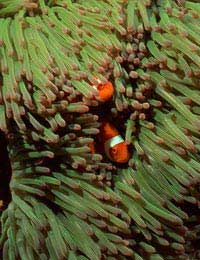Freeze and Dried Food

Providing suitable nutrition is an important part of keeping a successful aquarium and feeding time is also something which should be fun for you and your fish. But live food is tricky to organise and runs the risk of introducing disease organisms. Can you really give your fish the healthy diet they need using just frozen and dried foods?
The answer is that it depends on the needs of the particular species of fish you've chosen to keep. Some fish must be provided with live food, whilst still others need to be able to find suitable grazing within the aquarium ecosystem itself. Most, however, can do well on a diet of frozen or dried food if they can be persuaded to accept it. Such foods are convenient because they are easy to store and have a long shelf-life. This is particularly useful if you live a long way from your nearest fish shop.
Making Food Appealing
Many carnivores have strong instincts which keep them from eating anything that doesn't move. In the wild, this keeps them from eating dead things, which are more likely to harbour disease organisms. Once they've learned that frozen or dried food is tasty, they can usually overcome these instincts, but to overcome their initial hesitation you're going to have to make the food look as if it's alive.The usual way of presenting food like this is to attack it to the end of a chopstick or a piece of plastic tubing and lower it into the aquarium in front of the fish, then wiggle it around as if it were swimming. You may need to do this a few times before your fish get the hang of it. Be patient and don't worry about looking foolish - getting your fish to eat is the most important thing.
Many fish won't approach food which looks too big for them, so always be ready to break it up into appropriately sized pieces before feeding. This applies not only to frozen food, but also to dried foods which often come in cubes. These are best managed by dissolving them in a glass of water before adding them to the aquarium.
Sharing Your Food
With some species of fish, things are even more convenient, because you can feed them with the same products you might choose to eat yourself. Carnivorous marine fish often enjoy prawns, clams, cockles, mussels and shrimp, and these foods are highly nutritious. Make sure they are thoroughly thawed out before feeding and cut them into pieces of an appropriate size for your fishes' mouths. Never use seafood which has been pickled or preserved in brine, as this may contain chemicals toxic to your fish.Commercial Products
There are several different frozen and dried foods available for your aquarium. If you can't get hold of them at your local fish shop, try ordering them over the internet. Among the most popular are the following:- Brine shrimp -High in protein and in healthy fatty acids, brine shrimp make a great treat for most species of fish, though they're too rich to recommend for everyday eating.
- Daphnia -This makes a great basic diet for almost all fish, as well as for corals and anemones. Enriched varieties are available with more of the vitamins and minerals your fish need. If you use a plain variety, make sure to provide other foods from time to time as well.
- Bloodworm -A favourite with many species of fish, bloodworm are high in protein and vitamins. They're best fed as a treat rather than as an everyday food.
- Krill -Low in salt and fat, krill makes a good dietary mainstay for most carnivorous and omnivorous fish.
- Tubifex - High in protein,tubifex encourages growth and makes a great treat for freshwater fish. It can be used as a conditioning food to get your fish in good shape prior to breeding.
- Plankton -Freeze dried plankton is the safest kind to feed to your fish, and it remains rich in vitamins and minerals. It's an important supplement in marine diets.
Frozen and dried food makes it easy to keep a range of foods in your home so that you can provide a really good diet and bring out the best in your aquarium.


Re: Providing Toys for Your Fish
Toys for my baby Flowerhorn fish??? And where to buy them ?
Re: Snail Infestations in Your Fish Tank
My coy fish just started darting and running into the glass. I've checked them over and see nothing on the outside of…
Re: My Pet Fish is 20 Years Old is this a Record?
I purchased a gold fish on April 1997 for my daughters and the same fish is alive and well. The reason I'm…
Re: Dealing with Bullying Between Fish
I have 3 Bolivian butterfly rams not sure the genders,but at the start all 3 were fine but just recently we’ve notice 2…
Re: Using Electrical Devices Safely In Your Aquarium
Monthly water changes isn’t enough I would be changing at least a 1/3 weekly. I do it more often than…
Re: Dealing with Bullying Between Fish
I have a blue gourami that has been living with 4 platty’s and a yoyo loach. I noticed a couple of my fish missing. I…
Re: Lighting for Aquatic Animals
Will a UV submersible light harm my tropical tank and fish. Thanks for any help
Re: Dealing with Bullying Between Fish
Recently put 12 new Africans in my 55 gallon tank. Many rocks and hiding places. After 2,3 days one of them, obliquidens,…
Re: Food Quantities
Just noticed smallest neon tetra tail is missing and white on the edges. Another also has half of tail missing. They was OK a few days ago. I only…
Re: Providing Toys for Your Fish
I have guppies and I think the ideas for toys might be too big, I have tried training them but they aren't responding.